Systaflam MR Capsule 10's
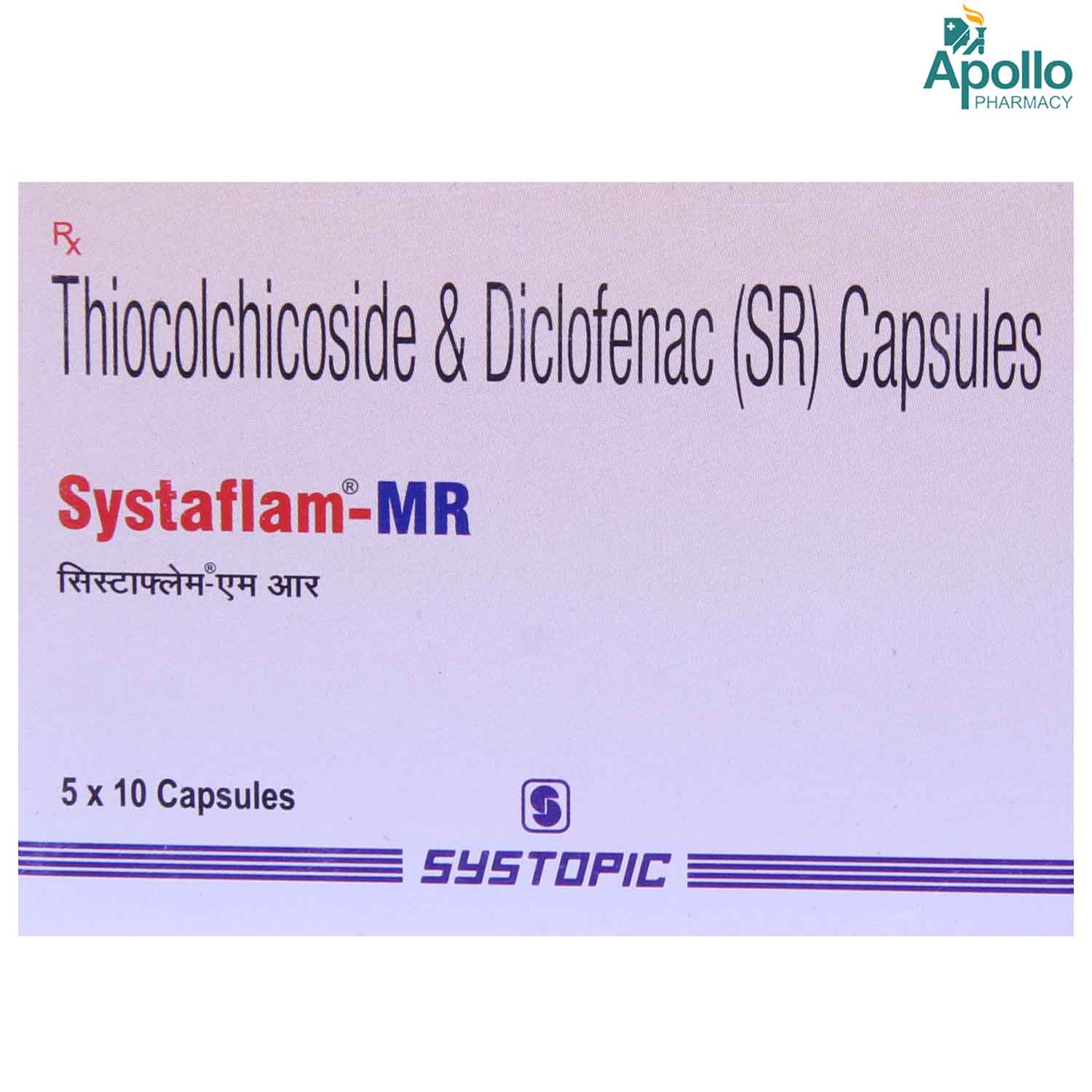
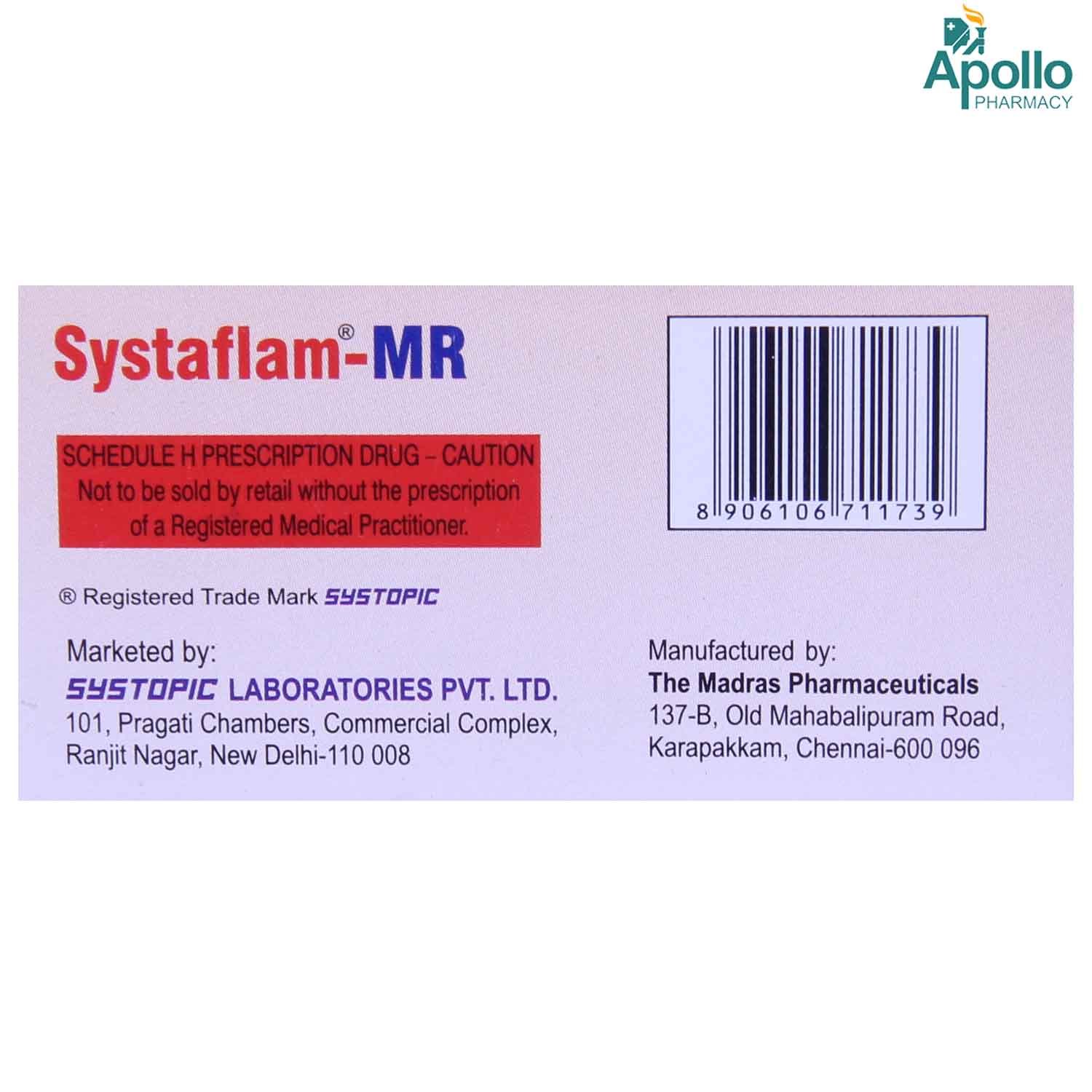
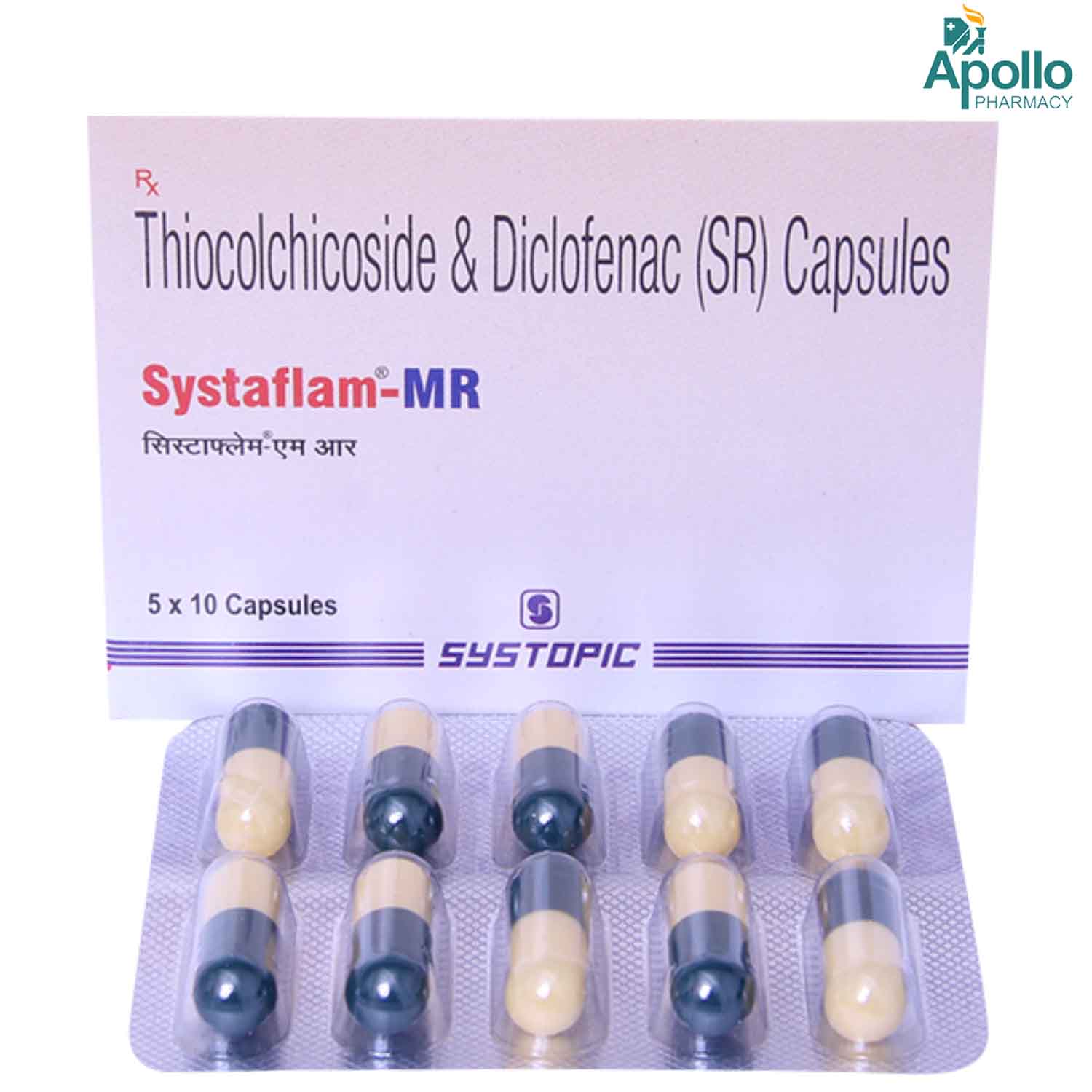
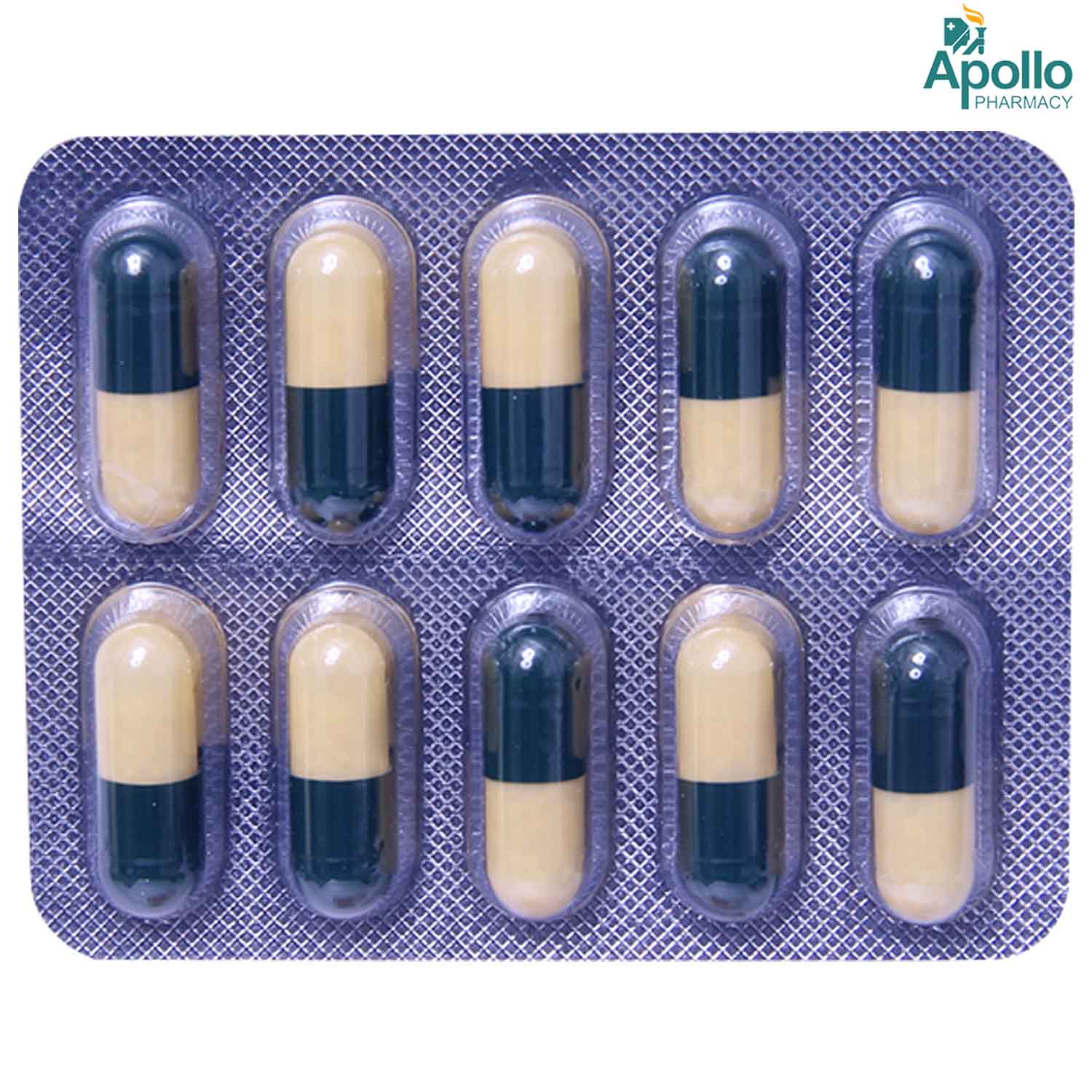
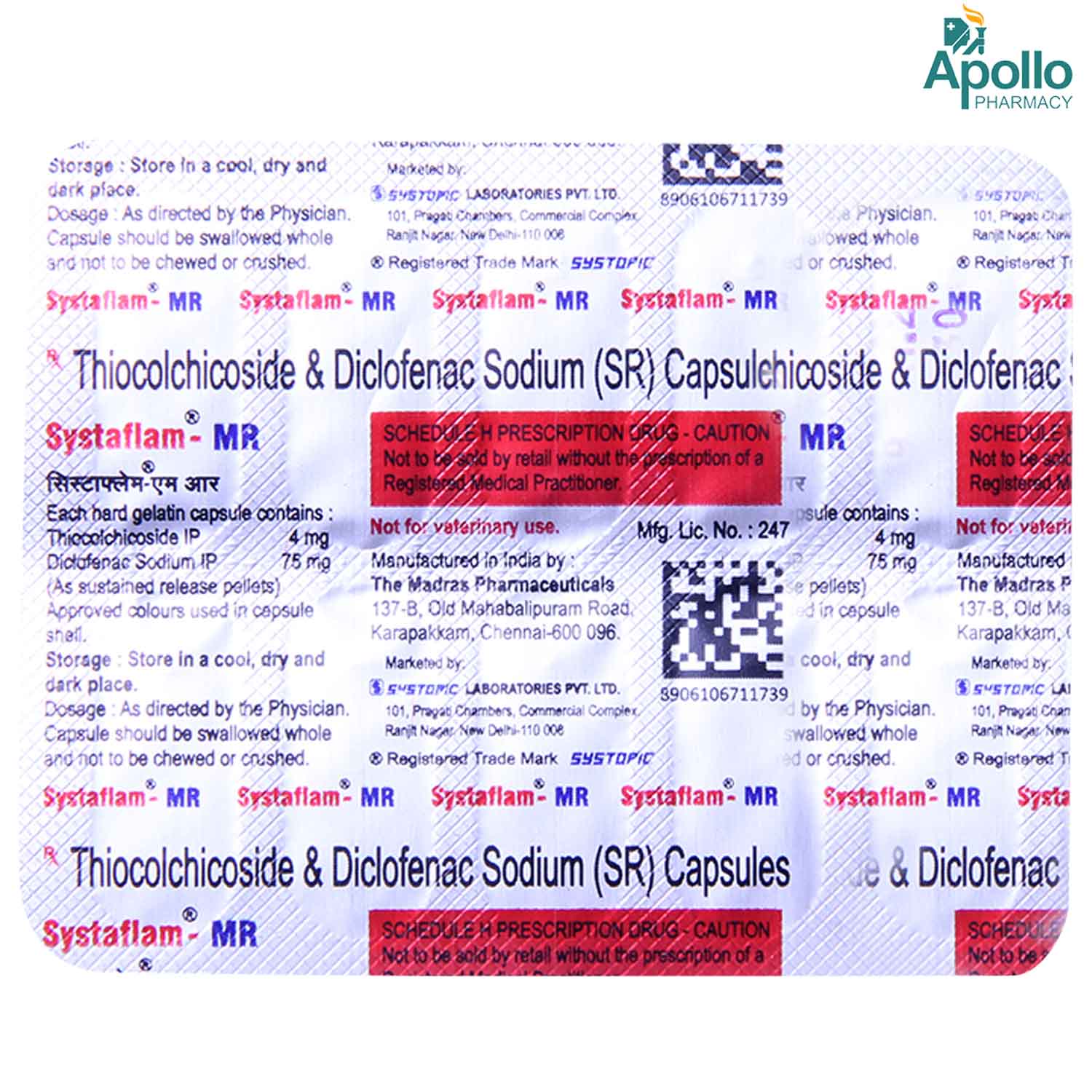





MRP ₹141
(Inclusive of all Taxes)
₹21.1 Cashback (15%)
Provide Delivery Location
Online payment accepted
 Prescription drug
Prescription drugWhats That
Composition :
Manufacturer/Marketer :
Consume Type :
Return Policy :
Expires on or after :
About Systaflam MR Capsule
Systaflam MR Capsule is a combination medication primarily used to reduce and relieve pain due to muscle spasms (painful muscular contractions) associated with degenerative vertebral disorders, torticollis (neck muscle contractions), and upper and lower back pain. Pain is a symptom triggered by the nervous system, causing uncomfortable sensations in the body. Muscle spasm is the sudden involuntary contractions of the muscle, which can be painful and uncomfortable.
Systaflam MR Capsule is a combination of two drugs: Diclofenac and Thiocolchicoside. Diclofenac is a non-steroidal anti-inflammatory drug (pain killer/NSAID) and relieves pain. It inhibits cyclo-oxygenase (COX) enzymes and further prevents the formation of chemical messengers, 'prostaglandins' (PGs), that cause pain and swelling at the injured or damaged site. Thiocolchicoside is a muscle relaxant that works on the centres of the spinal cord and brain. This helps reduce muscle stiffness and improves muscle movements, thereby relieving pain due to muscle spasms.
Your doctor will decide the dose and duration based on the severity of your pain. Common side effects of Systaflam MR Capsule include nausea, vomiting, loss of appetite, stomach pain, diarrhoea, and heartburn. These side effects are not familiar to everyone and vary individually. However, if the side effects are persistent, please reach out to your doctor.
Before starting Systaflam MR Capsule , inform your doctor if you have any liver, heart or kidney diseases, high blood pressure, diabetes, stomach ulcers, asthma, muscular hypotonia (decreased muscle tone), flaccid paresis (loose and floppy limbs), autoimmune diseases (systemic lupus erythematosus), and smoking habit. Systaflam MR Capsule is not recommended for pregnant and breastfeeding women. Systaflam MR Capsule should not be given to children and adolescents below 18 years of age as safety has not been established. Avoid consuming alcohol while undergoing treatment with Systaflam MR Capsule .
Uses of Systaflam MR Capsule
Directions for Use
Medicinal Benefits
Systaflam MR Capsule treats pain due to muscle spasms. It contains Diclofenac and Thiocolchicoside. Diclofenac is a non-steroidal anti-inflammatory drug (NSAIDs) and relieves pain. It inhibits cyclo-oxygenase (COX) enzymes that further prevents the formation of chemical messengers called 'prostaglandins (PGs). These prostaglandins are produced at injury sites and cause pain and swelling. By blocking COX enzymes' effect, lesser PGs are produced, which reduces mild to moderate pain and inflammation at the injured or damaged site. Thiocolchicoside is a muscle relaxant that works on the centres of the spinal cord and brain. This helps reduce muscle stiffness and improves muscle movements, thereby relieving pain due to muscle spasms.
Storage
Drug Warnings
Inform your doctor if you have any liver, heart or kidney diseases, high blood pressure, diabetes, stomach ulcers, asthma, muscular hypotonia (decreased muscle tone), flaccid paresis (loose and floppy limbs), autoimmune diseases (systemic lupus erythematosus), and smoking habit. Please consult your doctor before starting Systaflam MR Capsule if you have high cholesterol, chickenpox, porphyria (rare inherited disorder), hereditary disorders like Lapp lactase deficiency (lactose intolerance), galactose intolerance, glucose-galactose malabsorption (small intestines not being able to absorb and use glucose and galactose), fits, and blood clotting disorders. Do not take any other NSAIDs for pain relief along with Systaflam MR Capsule unless prescribed. Stop taking Systaflam MR Capsule and consult your doctor immediately if you have stomach pain or any signs of bleeding in the intestine or stomach, such as blood in stools. Systaflam MR Capsule is not recommended for pregnant and breastfeeding women. Systaflam MR Capsule may cause dizziness and drowsiness, so drive only if you are alert and focused. Avoid consuming alcohol while being treated with Systaflam MR Capsule . This medicine is not recommended in children and adolescents below 18 years of age as safety and efficacy are not established.
Drug-Drug Interactions
Drug-Drug Interactions
Login/Sign Up
Co-administration of Systaflam MR Capsule with Meloxicam can increase the risk or severity of gastrointestinal side effects.
How to manage the interaction:
Taking Meloxicam with Systaflam MR Capsule is not recommended as it can possibly result in an interaction, it can be taken if your doctor has advised it. However, consult your doctor immediately if you experience symptoms such as dizziness, lightheadedness, red or black, tarry stools, coughing up or vomiting fresh or dried blood that looks like coffee grounds, severe headache, and weakness. Do not stop any medication without doctor's advise.
Taking Dasatinib together with Systaflam MR Capsule may increase the risk of bleeding.
How to manage the interaction:
There may be a possible interaction between Systaflam MR Capsule and Dasatinib but they can be taken together if a doctor has prescribed them. However, consult a doctor immediately if you experience dizziness, red or black, tarry stools, or severe headaches. Do not discontinue any medications without consulting a doctor.
Co-administration of Rivaroxaban together with Systaflam MR Capsule may increase the risk of unsual bleeding.
How to manage the interaction:
Co-administration of Systaflam MR Capsule and Rivaroxaban can lead to an interaction; it can be taken if advised by your doctor. However, if you experience any symptoms like unusual bleeding or bruising, dizziness, lightheadedness, red or black, tarry stools, coughing up or vomiting fresh or dried blood that looks like coffee grounds, severe headache, and weakness, consult your doctor immediately. Do not stop using any medications without a doctor's advice.
Taking Systaflam MR Capsule with human immunoglobulin may increase the risk of kidney problems.
How to manage the interaction:
Although there is an interaction between Human immunoglobulin and Systaflam MR Capsule, you can take these medicines together if prescribed by a doctor. However, consult the doctor immediately if you experience symptoms such as nausea, vomiting, loss of appetite, increased or decreased urination, sudden weight gain or weight loss, fluid retention, swelling, shortness of breath, muscle cramps, tiredness, weakness, dizziness, confusion, and irregular heart rhythm. Do not discontinue any medications without consulting a doctor.
Taking Systaflam MR Capsule and piroxicam can increase the risk of side effects such as ulcers, inflammation (redness, swelling), bleeding.
How to manage the interaction:
Co-administration of Systaflam MR Capsule and Piroxicam can lead to an interaction, it can be taken if advised by a doctor. However, if you experience any symptoms like unusual bleeding or bruising, dizziness, lightheadedness, red or black, tarry stools, coughing up or vomiting fresh or dried blood that looks like coffee grounds, severe headache, and weakness, consult a doctor immediately. Do not stop using any medications without a doctor's advice.
Concomitant use of Systaflam MR Capsule with dabigatran may increase the risk of stomach bleeding.
How to manage the interaction:
Taking Systaflam MR Capsule with dabigatran together possibly results in an interaction, it can be taken if your doctor has advised it. You should consult a doctor immediately if you experience any unusual bleeding or bruising or have other signs and symptoms of bleeding such as dizziness, light headedness, red or black, tarry stools, coughing up or vomiting fresh or dried blood that looks like coffee grounds, severe headache and weakness. Do not stop using any medications without first talking to your doctor.
Taking Systaflam MR Capsule with Vorapaxar can increase the risk of bleeding complications.
How to manage the interaction:
There may be a possible interaction between Systaflam MR Capsule and Vorapaxar, but they can be taken together if your doctor has prescribed them. However, consult your doctor immediately if you experience any unusual bleeding, dizziness, lightheadedness, red or black, tarry stools, coughing up or vomiting fresh or dried blood that looks like coffee grounds, severe headaches. Do not discontinue any medications without consulting your doctor.
Taking Valdecoxib with Systaflam MR Capsule may increase risk of side effects.
How to manage the interaction:
There may be a possible interaction between Systaflam MR Capsule and Valdecoxib but can be taken if prescribed by doctor. However, consult your doctor immediately if you experience any unusual bleeding or bruising or have other signs and symptoms of bleeding such as dizziness, lightheadedness, red or black, tarry stools, coughing up or vomiting fresh or dried blood that looks like coffee grounds, severe headache, and weakness. Do not stop any medications without consulting a doctor.
Taking prasugrel together with Systaflam MR Capsule may increase the risk of bleeding.
How to manage the interaction:
Co-administration of Systaflam MR Capsule and Prasugrel can lead to an interaction; it can be taken if advised by a doctor. However, if you experience any symptoms like unusual bleeding or bruising, dizziness, lightheadedness, red or black, tarry stools, coughing up or vomiting fresh or dried blood that looks like coffee grounds, severe headache, and weakness, consult your doctor immediately. Do not stop using any medications without a doctor's advice.
Co-administration of Systaflam MR Capsule with Sirolimus may increase the risk or severity of kidney problems.
How to manage the interaction:
Co-administration of Systaflam MR Capsule and Sirolimus can lead to an interaction, but it can be taken if advised by a doctor. However, consult a doctor if you experience any symptoms like nausea, vomiting, loss of appetite, increased or decreased urination, sudden weight gain or weight loss, fluid retention, swelling, shortness of breath, muscle cramps, tiredness, weakness, dizziness, confusion, and irregular heart rhythm. Do not discontinue any medications without consulting a doctor.
Drug-Food Interactions
Drug-Food Interactions
Login/Sign Up
Diet & Lifestyle Advise
- Exercising regularly helps in muscle stretching, reducing spasm, tear and sprain incidence. Mild exercises, such as jogging and walking are helpful for muscle stretching.
- Massages can also be helpful to ease the pain.
- Avoid wearing tight-fitting clothes; wear loose garments for proper blood circulation.
- Rest well and get plenty of sleep.
- Hot or cold therapy can help treat muscle spasms. Apply an ice or hot pack on the muscle for 15-20 minutes.
- Stay hydrated; drink plenty of water.
Side Effects of Systaflam MR Capsule
- Nausea
- Vomiting
- Stomach pain
- Diarrhoea
- Loss of appetite
- Heartburn
Habit Forming
Therapeutic Class
Author Details
We provide you with authentic, trustworthy and relevant information
Drug-Diseases Interactions
Drug-Diseases Interactions
Login/Sign Up
FAQs
Systaflam MR Capsule contains Diclofenac and Thiocolchicoside. Diclofenac works by blocking the action of certain chemical messengers that cause pain and inflammation at the injured or damaged site. Thiocolchicoside is a muscle relaxant that relieves muscle stiffness due to muscle spasms and improves muscle movements.
Systaflam MR Capsule is usually prescribed for a short period and can be discontinued if there is no pain. To treat your condition effectually, continue taking Systaflam MR Capsule for as long as prescribed. Do not be reluctant to speak with your doctor if you feel any difficulty while taking Systaflam MR Capsule .
Diarrhoea can be a side-effect of Systaflam MR Capsule . Drink enough fluids and eat fibre rich food if you experience diarrhoea. If you find blood in stools (tarry stools) or experience excess diarrhoea, consult your doctor. Do not take anti-diarrhoeal medicine on your own.
It is not advised to use other NSAIDs or pain killers while using Systaflam MR Capsule . Please seek medical advice for further information.
You are not recommended to take Systaflam MR Capsule with warfarin as simultaneous use of these two medicines may increase the bleeding risk. However, if you are supposed to use these medicines together, please contact your doctor so that the dose may be adjusted or you may be prescribed alternate medicine.
Drug-Drug Interactions Checker List
- WARFARIN
- LITHIUM
- METHOTREXATE
- CICLOSPORIN
- TACROLIMUS
- TRIMETHOPRIM
- MIFEPRESTONE
- ASPIRIN
- IBUPROFEN
- DIGOXIN
- VORICONAZOLE
- PHENYTOIN
- COLESTIPOL
- CHOLESTYRAMINE
Special Advise
- Let your doctor know that you are taking Systaflam MR Capsule if you are undergoing any medical tests.
- Your doctor may recommend liver function tests to monitor your liver functioning.
Disease/Condition Glossary
Pain is a symptom triggered by the nervous system, causing uncomfortable sensations in the body.
Muscle spasm is the sudden involuntary contractions of the muscle, which can be painful and uncomfortable. When the nerve impulses that control the muscle movements are damaged or interrupted, it could lead to muscle spasms. Symptoms include muscle tightness, joint stiffness, unusual posture, difficulty moving, pain in affected muscles and joints. Fatigue (weakness), stress, extreme heat or cold, infection and tight clothing can trigger muscle spasms. Muscle relaxants and exercise can treat muscle spasms. Muscle relaxants sedate the muscle and help in inhibiting painful contractions. At the same time, exercise helps in muscle stretching to be less likely to spasm, tear and sprain.

Have a query?
Buy best C.n.s Drugs products by
Intas Pharmaceuticals Ltd
Sun Pharmaceutical Industries Ltd
Torrent Pharmaceuticals Ltd
Alkem Laboratories Ltd
Abbott India Ltd
Cipla Ltd
Alteus Biogenics Pvt Ltd
Micro Labs Ltd
Lupin Ltd
Ipca Laboratories Ltd
D D Pharmaceuticals Pvt Ltd
Icon Life Sciences
Mankind Pharma Pvt Ltd
Tripada Healthcare Pvt Ltd
Arinna Lifesciences Ltd
Linux Laboratories Pvt Ltd
East West Pharma India Pvt Ltd
La Renon Healthcare Pvt Ltd
Talent India Pvt Ltd
Tas Med India Pvt Ltd
Zydus Healthcare Ltd
Cnx Health Care Pvt Ltd
Eris Life Sciences Ltd
Leeford Healthcare Ltd
Emcure Pharmaceuticals Ltd
Macleods Pharmaceuticals Ltd
Sigmund Promedica
Aristo Pharmaceuticals Pvt Ltd
Dr Reddy's Laboratories Ltd
Troikaa Pharmaceuticals Ltd
Consern Pharma Ltd
Zydus Cadila
Shine Pharmaceuticals Ltd
Wockhardt Ltd
Ardent Life Sciences Pvt Ltd
Crescent Formulations Pvt Ltd
Theo Pharma Pvt Ltd
Reliance Formulation Pvt Ltd
Ikon Pharmaceuticals Pvt Ltd
Propel Healthcare
Neon Laboratories Ltd
Jagsam Pharma
Msn Laboratories Pvt Ltd
Morepen Laboratories Ltd
Pulse Pharmaceuticals
Sanofi India Ltd
Med Manor Organics Pvt Ltd
Hetero Healthcare Pvt Ltd
Novartis India Ltd
Crescent Therapeutics Ltd
Elder Pharmaceuticals Ltd
Solvate Laboratories Pvt Ltd
Akumentis Healthcare Ltd
Mova Pharmaceutical Pvt Ltd
Psyco Remedies Ltd
Tripada Lifecare Pvt Ltd
Ajanta Pharma Ltd
Cyrus Remedies Pvt Ltd
Medishri Healthcare Pvt Ltd
Cadila Healthcare Ltd
Glenmark Pharmaceuticals Ltd
Matteo Health Care Pvt Ltd
Hbc Life Sciences Pvt Ltd
Lyf Healthcare
Matias Healthcare Pvt Ltd
Mesmer Pharmaceuticals
Alembic Pharmaceuticals Ltd
Capital Pharma
Crescent Pharmaceuticals
Medopharm Pvt Ltd
Alniche Life Sciences Pvt Ltd
Kivi Labs Ltd
Talin Remedies Pvt Ltd
USV Pvt Ltd
Quince Lifesciences Pvt Ltd
Solis Pharmaceuticals
Infivis Life Care
Zuventus Healthcare Ltd
Cadila Pharmaceuticals Ltd
Pfizer Ltd
Wallace Pharmaceuticals Pvt Ltd
A N Pharmacia Laboratories Pvt Ltd
Blue Cross Laboratories Pvt Ltd
Jenburkt Pharmaceuticals Ltd
Lia Life Sciences Pvt Ltd
Mano Pharma
Medley Pharmaceuticals Ltd
Primus Remedies Pvt Ltd
FDC Ltd
Maneesh Pharmaceuticals Ltd
Apex Laboratories Pvt Ltd
Gagnant Healthcare Pvt Ltd
Ozone Pharmaceuticals Ltd
RPG Life Sciences Ltd
Strides Shasun Ltd
Unichem International
GlaxoSmithKline Pharmaceuticals Ltd
Kuresys Labs Pvt Ltd
LA Pharma
Trion Pharma India Llp
Alcohol
Caution
You are recommended to avoid alcohol consumption while taking Systaflam MR Capsule to avoid the risk of adverse effects.
Pregnancy
Unsafe
Systaflam MR Capsule is not recommended during pregnancy since it may harm the developing baby. Please consult your doctor for more information.
Breast Feeding
Unsafe
Systaflam MR Capsule is not recommended during breastfeeding as it may be excreted in breast milk and cause adverse effects in the baby. Please consult your doctor if you are a nursing mother.
Driving
Caution
Systaflam MR Capsule may make you feel dizzy, sleepy and can cause vision problems sometimes. Do not drive or operate machinery if you experience dizziness or drowsiness.
Liver
Caution
Please consult your doctor since Systaflam MR Capsule should be used with caution in patients with liver impairment/liver disease.
Kidney
Caution
Please consult your doctor since Systaflam MR Capsule should be used with caution in patients with kidney impairment/kidney disease.
Children
Unsafe
Systaflam MR Capsule is not recommended in children and adolescents younger than 18 years of age.






